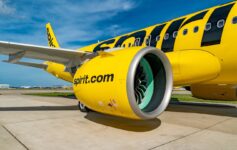Avianca has announced tie-ups with a couple of airlines in a landmark deal in recent weeks and is quickly setting the pace for growth and change in Latin America.
If you are considering booking travel or signing up for a new credit card please click here. Both support LiveAndLetsFly.com.
If you haven’t followed us on Facebook or Instagram, add us today.
Avianca Announces New Airline Tie-Ups
It’s been about a month since Avianca announced it would merge with Viva, both based in Colombia (Viva also has a base in Perú) but flying to a mix of Latin American destinations. Viva is a discount carrier similar to EasyJet in Europe and covers short-haul destinations through the southern Central American, Caribbean, and northern South American markets. Avianca, a member of the Star Alliance, serves North America and several European destinations as the Colombian flag carrier.
Following on that news, a merger in its own right that would involve adding Viva’s 22 aircraft and 1,200 employees, Gol is joining the merged carrier under a new banner, the discount carrier of Brazil. The new combined business (three airlines just a month ago) will operate under the new name, Abra, with leadership from Gol and Avianca. The tie-up is similar to IAG owning Vueling, Iberia, Aer Lingus, and British Airways.
The combined carriers, subject to legal and regulatory approval in Colombia, Perú, and Brazil, would create a network of airlines (on paper) nearly equal to LATAM. LATAM, a combination of LAN (formerly oneworld) and TAM (formerly Star Alliance) didn’t join SkyTeam post-merger but did form a close relationship following a $1.9bn USD investment from Delta Air Lines. LATAM has a substantial schedule in Latin America but offers a more extensive network globally.
Will Abra Be A True Competitor to LATAM?
The inimitable airline insider, Cranky Flier, produced a great piece about the combined carriers. He discussed reasons why the size of the airline won’t remain the same. He mentions that a press release during the pandemic suggested Avianca and Sky (Chile) were seeking closer ties but nothing materialized. However, with Sky, Abra would have a meaningful presence across the continent.
“Combined with Sky, Avianca would be a clear number two in Chile with nearly 20 percent of the market, and the same in Peru with about 15 percent. This gives Avianca a meaningful presence in the top 5 South American markets where there’s actually an ability to have a meaningful presence. (I exclude Argentina and Bolivia because protectionist policies in each country effectively keep any external airlines from becoming competitive.)
A look at the July 2022 schedule shows that bringing all these airlines together would create something slightly larger than LATAM with 7.9 million seats on just over 45,000 departures compared to 7.7 million seats on just shy of 42,500 departures at LATAM. This, of course, might not stay that way. There would be [a] rationalization of capacity and all that, but it competes a meaningful, viable second airline in South America.” – Cranky Flier
LATAM is every bit the network carrier that LAN and TAM were independently. Its equipment included A350s (before adjustments during the pandemic which sent those examples to Delta, Qatar, and even the desert) though now is all Boeing with a variety of large capacity, long-haul aircraft from the 767 to the 787 serving markets across the world.
Avianca, flies just to Madrid and Barcelona from Bogota at the moment but previously covered a number of additional destinations in Europe. Is it possible for the Abra group to compete with LATAM if operating nearly solely from within the Americas? It will because it’s changing the method of doing business.
Setting The Pace
Southwest Airlines became the largest domestic carrier in the US years ago and mostly held that title (everything got a little out of alignment during COVID) even before they operated flights to Hawaii. The carrier expanded to Central American destinations selectively but still doesn’t touch South America (though its Aruba is less than 100 miles away), doesn’t fly to Europe, and doesn’t operate flights to Canada. In fact, it’s only been with the expansion into Hawaii that Southwest recently added redeye flights.
Why talk about Southwest in an article about the new Abra group? Because Southwest did things differently despite being domestically focused.
Abra doesn’t need to focus on growth from major outside markets because it is becoming the Southwest of the Americas. If it succeeds in its three-prong merger, the company can continue to operate a more significant market segment in Latin America and grow only as demand warrants. The carrier has bigger aircraft with longer legs than Southwest and crosses far more international barriers, however, if Abra is happy to continue building a stronger network within the continent, it may overwhelm and steal market share from LATAM.
Additionally, Abra has some conflicts that it will have to resolve. Avianca is a member of Star Alliance, and partners with United Airlines among other carriers. Gol, like LATAM, has an investor in American Airlines ($200MM for 5.2%) which partners on its loyalty program and of course its flights.
Perhaps it doesn’t choose to leave Star Alliance but also keeps the American Airlines relationship. Why not? Abra is clearly looking to grow as fast, and as large as possible and needs all available options to do so. Besides, unlike other carriers, Abra is already operating differently, so why not take a duality approach to partner flights and codeshares? The pace Abra has set for mergers, adjustments, and expansion is fast and breaking social norms, why not challenge them all?
Conclusion
The concept of approaching a combined airline business with three carriers headquartered in three different countries at the same time is bold. If it passes regulatory approval, the carrier has the opportunity to do something that simply isn’t done with a variety of tie-ups that cross alliances and build a carrier that serves the Americas in a broad manner. Whether all of this can be achieved remains to be seen.
What do you think? Is Abra likely to be successful? Do you think they can reinvent a supercarrier in the Americas?




Wholeheartedly agree.
Hopefully they keep the skeleton of lifemiles & the customer service from Gol. I loathe calling them.
LATAM and Avianca are completely mismanaged and constantly on treacherous ground financially. Imagine Eastern and Pan Am being your two largest carriers battling it out. GOL alone was not bad, but they are in for a ride with the rest.
Honestly, I am very surprised you are not mentioning the obvious, Azul. It’s by far the best run airline in S.A. and under Neeleman’s care has a very loyal following that extends into Europe and the U.S. Neeleman is also more than capable of gradually expanding into other S.A. regional and domestic markets. Further, a tie in with Breeze, his new startup) and Jet Blue (his former) allows him some pretty nice feeder options in the U.S. so as to expand even beyond Florida. Further, his stake in TAP is also a potential huge benefit to Azul over time as these carriers emerge from the Covid years of chaos.
“it’s only been with the expansion into Hawaii that Southwest recently added redeye flights”
Really? What flights are those? I haven’t seen any red eyes come up in my searches from Hawaii to the east coast
I should rephrase that because the carrier doesn’t truly offer redeye flights, but around the same time as the launch of the Hawaii routes, Southwest pushed the bounds of what they would fly overnight (IT systems issues prevented this prior.) That said, Hawaii to the east coast on Southwest would have at least one if not two stops anyway.
You should read up on how to use a parentheses correctly. If you want to be a writer, please invest the time to write properly and proofread your work.
For the record, this also applies to a fair amount of Matt’s writing and also Lucky’s writing. I don’t notice it as often with TPG.